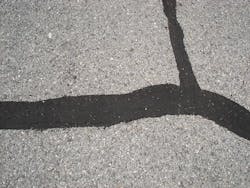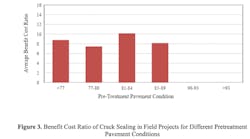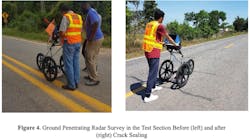Challenges and solutions for crack sealing in asphalt pavements
Surface cracking in asphalt concrete is a major failure mechanism that develops over the pavement service life. In general, surface cracks are primarily caused by traffic loading and temperature variations [1]. It is well recognized that water infiltration through cracks may accelerate pavement deterioration resulting in major problems such as moisture damage, base failure, and potholes [2; 3]. One of the most common treatments used to control surface cracks is crack sealing, which is categorized as a preventive maintenance method [4]. As shown in Figure 1, crack sealing is a surface treatment technique where hot-poured bituminous-based materials are applied into transverse and/or longitudinal cracks. Crack sealing has received considerable interest in the U.S. in recent years. In states like Louisiana, 70% of the districts use crack sealing for pavement preservation with average annual expenditure of about $91,000 per district as in 2016. Although this is a relatively significant expenditure, the optimum timing of crack sealing application is still based on field experience. In addition, the effect of crack sealing on moisture damage is unknown, especially with high groundwater table.
Research studies were recently initiated to evaluate the field performance of crack sealing [5; 6]. Based on the results of these projects, states such as Alaska and Georgia reported an extension in pavement service life between one and two years, while states such as Ohio and Kansas reported an extension in pavement service life between three and five years. On the other hand, other states such as Illinois and Minnesota experienced an extension in pavement service life between 6 and 8 years. These wide variations in crack sealing benefits relate to differences in the following construction practices: pavement conditions before crack sealing—i.e., pretreatment pavement conditions—traffic volume, climate conditions, etc. Therefore, it is important that the field performance of crack sealing is thoroughly evaluated and quantified.
To address this challenge, the authors analyzed several crack-sealed asphalt pavements and found that crack sealing extends pavement service life by one to nine years with an average of 5.6 years depending on the daily traffic level and the pretreatment pavement conditions (see Figure 2). In general, pretreatment pavement condition is quantified using a numerical index that ranges from zero to 100, with 100 being perfect conditions [7]. Therefore, the authors developed a simple regression model that estimates the extension in pavement service life due to crack sealing based on the average daily traffic level and the pre-treatment pavement conditions rating. For a specific candidate project for crack sealing, knowing the existing pavement condition rating and the average daily traffic level, agencies could use this developed model during planning of maintenance activities to select the optimal timing for future treatments following crack sealing and avoid inadequate allocation of maintenance and rehabilitation funds.
Another common challenge of crack sealing is the optimal timing of application of this treatment. Most of agencies in the U.S. find it difficult to determine when to apply crack sealing to the existing pavement to be cost-effective. It is well recognized that when crack sealing is applied too soon to the pavement, it adds little benefits since nearly all the remaining performance of the original pavement is still unused. Similarly, when crack sealing is applied too late near the end of the asphalt pavement life, it is expected to have a minimal effect on improving pavement performance since the pavement is already in the advanced stages of deterioration [8]. Hence, most of the state agencies tend to apply crack sealing based on visual inspection and past experience without quantitatively considering the condition rating of the existing pavement, i.e. pre-treatment pavement condition rating. Therefore, it is important to evaluate the cost-effectiveness of crack sealing to be able to determine the optimal application timing of this treatment.
To address this challenge, the authors evaluated the cost effectiveness of several crack sealing projects using common economic measures. The computed economic measures for the different crack sealing projects were analyzed to determine the optimal timing of crack sealing. Based on this analysis, the authors concluded that crack sealing should be completely avoided on asphalt pavements having pavement condition rating greater than 89 (pavements in relatively good condition) because in this case crack sealing adds negligible benefits to the asphalt pavement since all the remaining performance of the original pavement is still unused. In addition, the authors concluded that the optimal timing of crack sealing application is when the pavement condition rating drops from 100 to any conditions between 81 and 85 (see Figure 3).
In addition to the previous challenges, the use of crack sealing in Louisiana has been limited as earlier studies showed that the performance of this maintenance practice can be affected by high groundwater table conditions [9]. According to these studies, crack sealing can prevent water from escaping upwards through the cracks by evaporation. This moisture entrapment accelerates moisture damage in asphalt pavements. Yet, the use of any impermeable treatment including chip seals on top of a pavement with high groundwater table may cause the same problem. In Texas, research projects indicated that surface sealing could prevent the evaporation of water that moves upwards through the pavement—therefore accelerating moisture damage in asphalt pavements [10]. Similar findings were reported in Colorado and Nebraska, as they noticed moisture damage in asphalt pavements due to water trapped underneath chip seals [11]. To this end, factors that may affect the crack sealing potential to cause moisture damage in asphalt pavements should be evaluated and quantified to ensure that crack sealing is applied without concerns about any potential moisture damage.
The authors selected and analyzed a test section in Louisiana with the help of the Louisiana Department of Transportation and Development (LaDOTD). Two site visits were conducted to this test section before and after crack sealing. In both site visits, the authors scanned the entire test section with a ground penetrating radar, which has the ability to detect the subsurface moisture under the pavement, as shown in Figure 4. Other collected data during the site visits encompassed the drainage features of the asphalt pavement, crack severity, crack intensity, pavement layer thicknesses, pavement layer types, etc. Using the collected data and through extensive laboratory testing and finite element modeling, the authors drew the following key conclusions:
- Crack sealing could be applied under any rain intensities and for any groundwater table depth without the potential for moisture damage in asphalt pavement due to moisture entrapment if the original pavement is relatively impermeable (water permeability is less than 2x10-6 m/s).
- Crack sealing should be applied after an extended dry period to ensure that the existing water inside the asphalt pavement is minimal.
- Unsealed cracks in regions with relatively low air relative humidity and deep groundwater table are not expected to experience moisture damage (stripping) due to the accelerated drainage by evaporation.
Based on the aforementioned conclusions, the authors designed a user-friendly tool in the form of a spreadsheet that could be used by state agencies during planning for crack sealing. This tool requires the user to input key project conditions such as the average daily traffic volume, thickness of the existing asphalt pavement, pavement condition rating, etc. For each input, typical ranges and recommended values are provided to guide the user in selecting the design values. Based on the provided input values, the tool would determine the optimal timing of crack sealing and evaluate the potential of moisture damage in the asphalt pavement after crack sealing.
Acknowledgements:
The financial and technical support of the Louisiana Transportation Research Center (LTRC) is greatly appreciated. The authors also acknowledge the help of District 58 in Louisiana.
References:
-
Caltrans. Maintenance Technical Advisory Guide (MTAG). California Department of Transportation, Office of Pavement Preservation, 2003.
-
Final Report, NCHRP Project 1-37A: Guide for Mechanistic–Empirical Design of New and Rehabilitated Pavement Structures. Transport Research Board, National Research Council, Washington, D.C., 2004.
-
Apul, Defne S., et al. A Review of Water Movement in the Highway Environment: Implications for Recycled Materials Use. Recycled Materials Resource Center, University of New Hampshire, Durham, 2002.
-
Zaniewski, John P., and Michael S. Mamlouk. Pavement Maintenance Effectiveness-Preventive Maintenance Treatments. PARTICIPANT'S HANDBOOK. No. FHWA-SA-96-027, 1996.
-
Rajagopal, A. Effectiveness of Crack Sealing on Pavement Serviceability and Life. Publication No. FHWA/OH-2011/ 14. Ohio Department of Transportation, 2011.
-
Eaton, Robert A., and Jane Ashcraft. State-of-the-Art Survey of Flexible Pavement Crack Sealing Procedures in the United States. No. CRREL-92-18. COLD REGIONS RESEARCH AND ENGINEERING LAB HANOVER NH, 1992.
-
Khattak, M. J., Baladi, G. Y., Zhang, Z., & Ismail, S. A Review of the Pavement Management System of the State of Louisiana-Phase. Transportation Research Record, pp. 18-27, Washington, D.C, 2008.
-
Morian, D. A. "Cost-Benefit Analysis of Including Microsurfacing in Pavement Treatment Strategies & Cycle Maintenance". FHWA-PA-2011-001-080503, 2011.
-
Zaniewski, John P., and Michael S. Mamlouk. “Pavement Maintenance Effectiveness -Preventive Maintenance Treatments”. PARTICIPANT'S HANDBOOK. No. FHWA-SA-96-027, 1996.
-
Kennedy, T., W., “Prevention of water damage in asphalt mixtures”, STP 899, American Society for Testing and Materials, pp 119-133, Philadelphia, 1985.
-
Johnson, David R., and Reed B. Freeman. “Rehabilitation techniques for stripped asphalt pavements”. No. FHWA/MT-002-003/8123, 2002.



